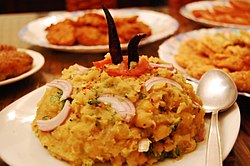Ghugni
 Ghugni | |
| Course | Snack |
|---|---|
| Place of origin | Bangladesh |
| Region or state | Bengal |
| Associated cuisine | Bengali cuisine |
| Main ingredients | Black gram, dried yellow peas or dried white peas, Indian spices, Turmeric powder |
Ghugni (Template:Lang-bn, Template:Lang-or) or ghuguni (Template:Lang-as, Template:Lang-or) or guguni (Template:Lang-or)is a curry made of peas or chickpeas.[1] Different variations of the dish use different types of peas or chickpeas, such as black gram, green peas, or white peas. It is a snack native to the Indian subcontinent, especially popular in Eastern India (Indian States of Jharkhand, Odisha, West Bengal), Northeast India (Indian states of Assam and Tripura) and in Bangladesh.[2]

Preparation
The peas are soaked overnight and then boiled in water. The peas are added to a gravy that includes coconut, ginger paste, garlic paste, cumin, tamarind paste, and cilantro.[2]
It is then served with puffed rice (kurmura) and at times with hot onion pakoda or bhajiya.[3]
Ghugni is often served with dhuska, a fermented rice-lentil dish.[1] In Calcutta, ghugni is often eaten with puris.[4]
Variation

In Bihar, green chickpeas or freshly harvested green peas are used for the dish. They are lightly pan fried in mustard oil with some cumin seeds and green chillies and are not curried like eastern Indian versions.[5] In Bengal, ghugni is made from dry white peas.[6]
Some versions include meat, such as goat or even lamb or chicken. The meat is usually minced or in bite-sized pieces, mostly for flavoring. "Mangsher ghugni" or meat keema ghugni has been described as a "Kolkata trademark".[7][8]
See also
References
- ^ a b Singh, Usha. "Ethnic Fermented Foods of Bihar and Jharkhand". Ethnic Fermented Foods and Beverages of India: Science History and Culture: 113 – via Springer Nature.
- ^ a b Kapoor, Sanjeev (2011). How to Cook Indian: More Than 500 Classic Recipes for the Modern Kitchen. ABRAMS. ISBN 9781613121351.
- ^ Majumdar, B. (2013). Cooking On The Run. HarperCollins India. ISBN 978-93-5029-945-6.
- ^ Dasgupta, Minakshie; Gupta, Bunny; Chaliha, Jaya (1995). The Calcutta Cookbook: A Treasury of Over 200 Recipes from Pavement to Palace. Penguin Books. p. 371. ISBN 9780140469721.
- ^ Kumar, Prasanjeet; Kumar, Sonali (2016). The Ultimate Guide to Cooking Vegetables the Indian Way. CreateSpace Independent Publishing Platform. ISBN 9781537268132.
- ^ Roy, Dayeeta (2014). The Gift of Life: Family, Friends, Food & Fun. Partridge Publishing India. ISBN 9781482842913.
- ^ "Ghugni: The Iconic Street Side Snack Bengal Can't Do Without". NDTV Food. Retrieved 2 October 2020.
- ^ Bhattacharya, Rinku. "Try ghugni instead of chili". Poughkeepsie Journal. Retrieved 2 October 2020.
External links



